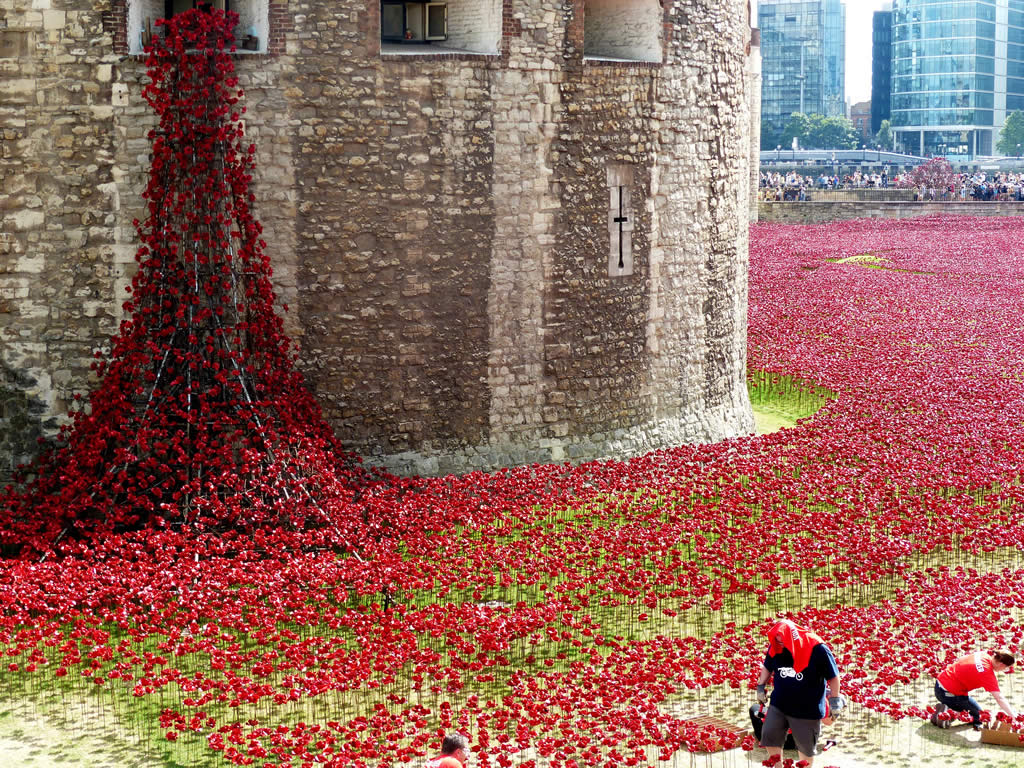There were many happy twists of fate that led to Britain’s most visited and talked about public art installation for a generation, not least the fluke discovery of a remarkable sentence in an unknown soldier’s will and a fortunate case of mistaken identity. But ultimately the poppies at the Tower of London happened because of one artist’s powers of persuasion. “I do talk people to death until I get an answer,” admitted Paul Cummins.
More than 5 million people are estimated to have visited ‘Blood Swept Lands and Seas of Red’ during the four months it appeared in the Tower’s moat. It was a deliberately simple idea. To commemorate the centenary of the outbreak of the World War I, there would be 888,246 ceramic red poppies gradually planted at the Tower of London. Each represented one life lost. By the end there would be a sea of red. Then they would disappear.
The crowds who gathered to see the installation were large and at times surprising. It became so popular towards the final weeks that British prime minister, David Cameron, and mayor of London, Boris Johnson led calls for it to be extended so more people could visit, according to the Guardian.
The reaction was overwhelmingly positive but there were detractors, chiefly the Guardian’s visual arts critic Jonathan Jones. He called it “a deeply aestheticized, prettified and toothless war memorial.”
Not everyone was so extreme in their views. There were many highly placed people in the art world who looked on the installation with affection. The chairman of Arts Council England, Sir Peter Bazalgette, said he thought the work would be remembered in 100 years’ time. At the centre of this maelstrom are Cummins, the ceramic artist who dreamed up the idea, and Tom Piper, the theatre designer who was brought on board by the Tower to stage the piece.
The seeds of the project can be seen in the ceramic roses that Cummins created during the Cultural Olympiad in 2012, one of the unlimited projects by disabled artists. The idea for the poppies came as he went through World War I archives in Chesterfield records office. By chance he found the will of an unknown soldier who died at Flanders which contained the line: “The blood-swept lands and seas of red, where angels fear to tread.”
“It was an accident I came across it and it just sparked something in my mind,” said Cummins. “I am horrendously dyslexic and I do see things in a different way to everyone else, because words to me are color. To see the actual note brought back memories of red.”
Cummins had the brainwave of making an installation with ceramic poppies representing each of the dead, so he rang the Tower of London. He got through to the Tower’s head of operations, John Brown, but only by chance, “because he knew somebody else called Paul Cummins”.
Things then began to move fast. “I do talk people to death until I get answer and actually it didn’t take that long. It was a couple of weeks and they said yes. It all blossomed from there.”
Piper, a freelance who works regularly at the Royal Shakespeare Company, was brought on board in autumn 2013 by Deborah Shaw, the head of creative partnerships at Historic Royal Palaces, to work out how to stage the idea.
He had the idea to create the Weeping Window, a cascade of poppies that spilled from a window, and the Wave, which swirled out of the moat to form an arch over the entrance to the Tower.
So why did it work, in the eyes of many, so well?
Piper said: “It has been an amazing and, at times, difficult journey and we’ve had to adapt. Initially, we thought we might plant the poppies in three weeks and it became clear that couldn’t happen, so we ended up with the slow planting which in the end made it better. “It became part of the work that it was always in a state of flux, always flowing. There was a great sense of theatre from the people planting, the people watching and then every night the roll of honor.” Cummins said the gradual planting meant using thousands of volunteers and their stories – whether they lost someone in a conflict or have sons and daughters serving abroad – have become part of the piece.
Then there are the numerous photographs taken by the public. “Everybody felt they could own it and of course a lot of them do now own it because they paid $38.50 for a poppy,” said Piper.
An estimated $15.4m has been generated for six charities from the sale of the poppies with the process of packing them up beginning the day after the war remembrance day (Armistice Day) anniversary, despite the pleas of politicians for the whole work to stay longer. Instead the Weeping Window and the Wave remained until the end of November and will tour the UK until 2018, when they will be given to the Imperial War Museums in London and Manchester.


